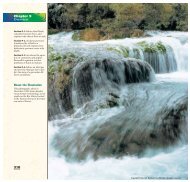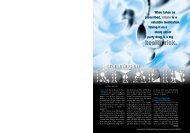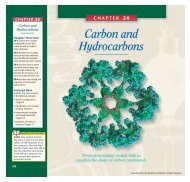Physical Characteristics of Gases
Physical Characteristics of Gases
Physical Characteristics of Gases
You also want an ePaper? Increase the reach of your titles
YUMPU automatically turns print PDFs into web optimized ePapers that Google loves.
You can understand Dalton’s law in terms <strong>of</strong> the kinetic-molecular<br />
theory. The rapidly moving particles <strong>of</strong> each gas in a mixture have an<br />
equal chance to collide with the container walls. Therefore, each gas<br />
exerts a pressure independent <strong>of</strong> that exerted by the other gases present.<br />
The total pressure is the result <strong>of</strong> the total number <strong>of</strong> collisions per<br />
unit <strong>of</strong> wall area in a given time. (Note that because gas particles move<br />
independently, the other gas laws, as well as Dalton’s law, can be applied<br />
to unreacting gas mixtures.)<br />
PO2 = 0.12 atm<br />
1 L container at 0 o C<br />
P N2 = 0.12 atm<br />
1 L container at 0 o C<br />
P Total = 0.24 atm<br />
1 L container at 0 o C<br />
Oxygen molecule, O 2<br />
FIGURE 10-14 Samples <strong>of</strong> oxygen gas and nitrogen gas are mixed.<br />
The total pressure <strong>of</strong> the mixture is the sum <strong>of</strong> the pressures <strong>of</strong> the gases.<br />
Copyright © by Holt, Rinehart and Winston. All rights reserved.<br />
Nitrogen molecule, N 2<br />
Oxygen molecule, O 2<br />
Nitrogen molecule, N 2<br />
PHYSICAL CHARACTERISTICS OF GASES 323<br />
SECTION 10-3<br />
Visual Strategy<br />
FIGURE 10-14 Point out that equal<br />
amounts <strong>of</strong> gas at the same temperature<br />
and volume have equal pressure.<br />
Application<br />
Dalton’s law <strong>of</strong> partial pressures has<br />
important applications for people<br />
who work at high altitudes, such as<br />
mountain climbers and pilots. For<br />
example, at an altitude <strong>of</strong> about<br />
10 000 m (higher than Mount<br />
Everest), air pressure is about<br />
one-third <strong>of</strong> an atmosphere. The<br />
partial pressure <strong>of</strong> oxygen at this<br />
altitude is 0.3 atm × 0.21 (percent <strong>of</strong><br />
O 2 in air) × 760 mm Hg, or less than<br />
50 mm Hg. By comparison, the partial<br />
pressure <strong>of</strong> oxygen in human alveolar<br />
blood needs to be about 100 mm Hg.<br />
Thus, respiration cannot occur normally<br />
at this altitude, and an outside<br />
source <strong>of</strong> oxygen is needed in order<br />
to survive.<br />
Additional Example<br />
Problem<br />
1. Calculate the partial pressure in<br />
millimeters <strong>of</strong> mercury exerted by the<br />
four main gases in air at 760 mm Hg:<br />
nitrogen, oxygen, argon, and carbon<br />
dioxide. Their abundance by volume<br />
is 78.08%, 20.95%, 0.934%, and<br />
0.035%, respectively.<br />
Ans. N2 : 593.4 mm Hg<br />
O2 : 159.2 mm Hg<br />
Ar: 7.10 mm Hg<br />
CO2 : 0.27 mm Hg<br />
323

















